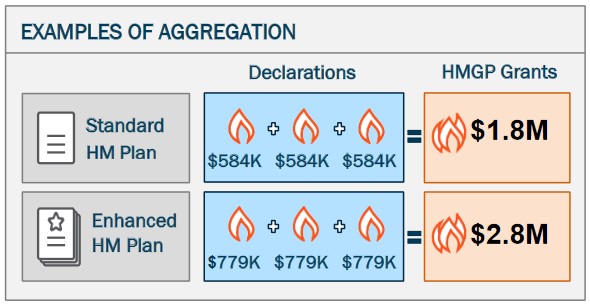FEMA places a high priority on supporting wildfire recovery using the Hazard Mitigation Grant Program Post Fire (HMGP Post Fire) for Fire Management Assistance declarations issued on or after October 5, 2018.
Learn about the types of wildlife recovery projects that typically receive the HMGP Post Fire grants, and how to apply.
Eligibility
Application Period
How Projects are Prioritized
Guidance
How Funding is Calculated
Eligibility
States, federally-recognized tribes, and territories affected by fires resulting in a Fire Management Assistance Grant (FMAG) declaration on or after October 5, 2018, are eligible to apply.
Applicants must have a FEMA-approved mitigation plan to receive HMGP Post Fire funding. Select "Fire Management Assistance" as the declaration type on our Disaster Declarations page to find declarations.
Note: An FMAG declaration, rather than a Presidential major disaster declaration, activates HMGP Post Fire assistance.
Application Period
FEMA will send a formal funding notification letter to eligible applicants outlining the dates of the application period.
The application period opens with the applicant’s first FMAG declaration of the fiscal year and closes at 11:59 PM Eastern Standard Time on the last day of the sixth month of the next fiscal year.
Application extensions may be requested. The state is required to submit a written request to the FEMA Regional Administrator for an extension.
How Projects are Prioritized
As part of the focus on hazard mitigation and resilience, FEMA encourages the mitigation of wildfire and related hazards. Prioritized project types are organized into five general categories, as outlined in the table.
Prioritized HMGP Post Fire Activities
| Project Type | Examples of Prioritized Projects |
|---|---|
| Wildfire Mitigation | Defensible space Reducing hazardous fuels Removing standing burned trees Ignition-resistant construction |
| 5-Percent Initiative | Installing warning signs |
| Infrastructure Retrofit | Strengthen or harden water systems that were burned and caused contamination |
| Soil and Slope Stabilization | Reseeding ground cover Planting grass to prevent spread of noxious weeds Mulching with straw or chipped wood Placing logs/other erosion barriers to catch sediment on slopes Installing debris traps to modify road and trail drainage mechanisms |
| Post-Wildfire Flood Prevention and Sediment Reduction | Modifying or removing culverts Adding drainage dips and constructing emergency spillways Constructing straw, rock, or log dams in small tributaries to prevent flooding |
Applicants must detail their respective management process, including deadlines, in their HMGP Administrative Plan. The administrative plan is a procedural guide that details how the applicant will administer the award.
Projects by Location
Funding will first be made available to the county, counties or burned tribal lands that received an FMAG declaration. A project may be outside of this area as long as the risk reduction activity benefits the declared county or counties (e.g., watershed mitigation). If funding cannot be used in the affected area, then it may be available statewide regardless of whether it benefits a declared county. However, if the funding is being used outside of the declared area, the application must explain why the assistance is not being used in the declared or burned areas.
Projects for Tribes
Federally recognized tribes with land burned in FMAG declarations may choose to apply to FEMA for HMGP assistance as an applicant once a state or territory receives an FMAG declaration. Tribes (including federally recognized tribes) may also apply through states as subapplicants. If tribal land is not burned, subapplicant funding may be unavailable, as assistance is prioritized for FMAG declared areas.
Projects for Nonprofits
Private nonprofits may act as subapplicants for HMGP Post Fire if they own or operate a private nonprofit facility as defined in Section 102(11)(B) of the Stafford Act.
Available Guidance
Download the below resources to help interpret federal statutes, regulations and best practices about mitigation strategies.
- FEMA Policy #207-088-2, Hazard Mitigation Grant Program - Post Fire. April 29, 2019
- FEMA Job Aid for Disaster Recovery Reform Act, Section 1205 Additional Activities for Wildfire and Wind Implementation under Hazard Mitigation Assistance Programs. December 3, 2019
- Wildfire guidance is found in the Hazard Mitigation Assistance Guidance. February 2015
- Examples of wildfire mitigation projects are detailed in the Hazard Mitigation Assistance Guidance Addendum. February 2015
How Funding is Calculated
The funding amount available will be provided by FEMA, and is a national aggregate calculation based on an average of historical FMAG declarations from the past 10 years. This amount will be recalculated at the beginning of every fiscal year. The total HMGP funding available for each FMAG declaration for FY22 is $786,552 for applicants with a standard hazard mitigation plan, and $1,048,736 for applicants with an enhanced hazard mitigation plan.
Funding from multiple events will be aggregated into one grant under the first declaration. This will support larger projects, streamline grants management, and expedite closeout. Aggregation will reset at the beginning of each fiscal year and will remain in effect for that year.

Management Costs
Recipients will be eligible for up to 10 percent of the award amount for management costs. Subrecipients will be eligible for up to 5 percent of the award amount for management costs. FEMA will provide one estimate of the management costs available under each HMGP Post Fire award, which will be included in the formal funding notification. The estimate will be subsequently increased as appropriate for each FMAG event that is aggregated.
See FEMA Policy #104-11-1, Hazard Mitigation Grant Program Management Costs (Interim), dated November 14, 2018.
Sharing Funds
Federally recognized tribes with burned land may apply as applicants once a state or territory receives an FMAG declaration. Funding will be apportioned based on each recipient's burned acreage. The apportionment will be calculated based on the amount of each recipient’s burned acreage as a percentage of the allotment to which they are entitled under the FMAG. FEMA Regional Administrators will have final authority on apportionment determinations.


